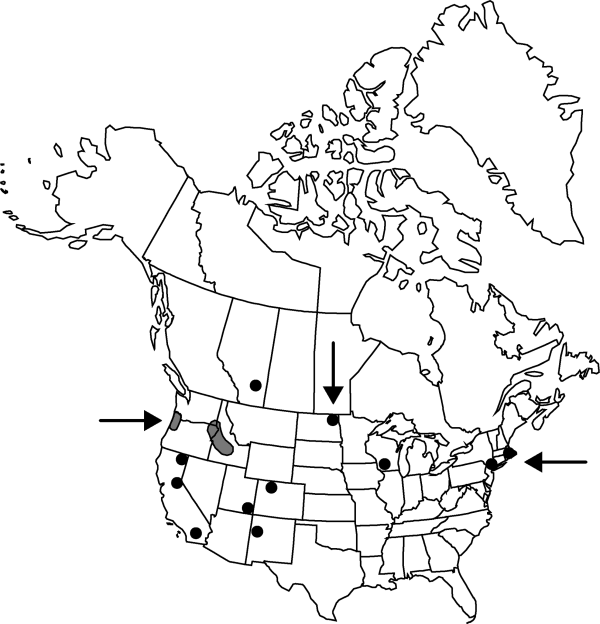Difference between revisions of "Chenopodium foliosum"
Fl. Brandenburg 1: 572. 1864.
FNA>Volume Importer |
FNA>Volume Importer |
||
| Line 26: | Line 26: | ||
|elevation=200-1800 m | |elevation=200-1800 m | ||
|distribution=Alta.;Calif.;Colo.;Idaho;Mass.;N.Mex.;N.Y.;N.Dak.;Oreg.;Utah;Wash.;Wis.;Eurasia;n Africa. | |distribution=Alta.;Calif.;Colo.;Idaho;Mass.;N.Mex.;N.Y.;N.Dak.;Oreg.;Utah;Wash.;Wis.;Eurasia;n Africa. | ||
| − | |discussion=<p>Chenopodium foliosum is probably native to the mountains of south and central Europe and western Asia. Several closely related segregate species are currently recognized within the C. foliosum group (P. Uotila 1979, 1993, 1997).</p><!-- | + | |discussion=<p><i>Chenopodium foliosum</i> is probably native to the mountains of south and central Europe and western Asia. Several closely related segregate species are currently recognized within the <i>C. foliosum</i> group (P. Uotila 1979, 1993, 1997).</p><!-- |
| − | --><p>Chenopodium foliosum listed and illustrated in J. C. Hickman (1993) is in fact C. capitatum var. parvicapitatum.</p> | + | --><p><i>Chenopodium foliosum</i> listed and illustrated in J. C. Hickman (1993) is in fact <i>C. capitatum </i>var.<i> parvicapitatum</i>.</p> |
|tables= | |tables= | ||
|references= | |references= | ||
| Line 52: | Line 52: | ||
|publication year=1864 | |publication year=1864 | ||
|special status= | |special status= | ||
| − | |source xml=https://jpend@bitbucket.org/aafc-mbb/fna-data-curation.git/src/ | + | |source xml=https://jpend@bitbucket.org/aafc-mbb/fna-data-curation.git/src/8f726806613d60c220dc4493de13607dd3150896/coarse_grained_fna_xml/V4/V4_514.xml |
|genus=Chenopodium | |genus=Chenopodium | ||
|subgenus=Chenopodium subg. Blitum | |subgenus=Chenopodium subg. Blitum | ||
Revision as of 18:28, 18 September 2019
Stems erect to ascending, branched, 1.4–6(–8) dm, glabrous. Leaves nonaromatic; petiole 0.5–6.5 cm; blade narrowly triangular, oblong-triangular, to almost deltate, 1.7–7.5(–9) × 0.8–3.5 cm, base subtruncate to broadly cuneate, often subhastate, margins coarsely laciniate-dentate or sinuate-dentate, apex acute to acuminate. Inflorescences glomerules in axils of leaflike bracts; glomerules globose, 3–8 mm diam.; bracts leaflike throughout inflorescence; flowers maturing from base to apex. Flowers: perianth segments 3(–4), connate only at base or connate into irregular lobes; lobes obovate, 0.5–0.7 × 0.3–0.7 mm, apex rounded, not keeled, glabrous, becoming red, enlarged, and fleshy in fruit; stamens usually 1; stigmas 2, 0.5 mm. Achenes ovoid; pericarp adherent, dark reddish brown, fleshy, smooth. Seeds round, 1–1.2 mm diam., margins rounded with an incised groove; seed coat dark red-brown, minutely reticulate-punctate.
Phenology: Fruiting summer–fall.
Habitat: Gravel bars, waste ground, cultivated grounds
Elevation: 200-1800 m
Distribution

Alta., Calif., Colo., Idaho, Mass., N.Mex., N.Y., N.Dak., Oreg., Utah, Wash., Wis., Eurasia, n Africa.
Discussion
Chenopodium foliosum is probably native to the mountains of south and central Europe and western Asia. Several closely related segregate species are currently recognized within the C. foliosum group (P. Uotila 1979, 1993, 1997).
Chenopodium foliosum listed and illustrated in J. C. Hickman (1993) is in fact C. capitatum var. parvicapitatum.
Selected References
None.